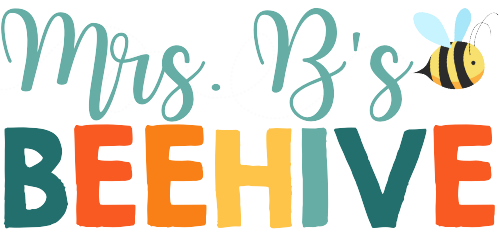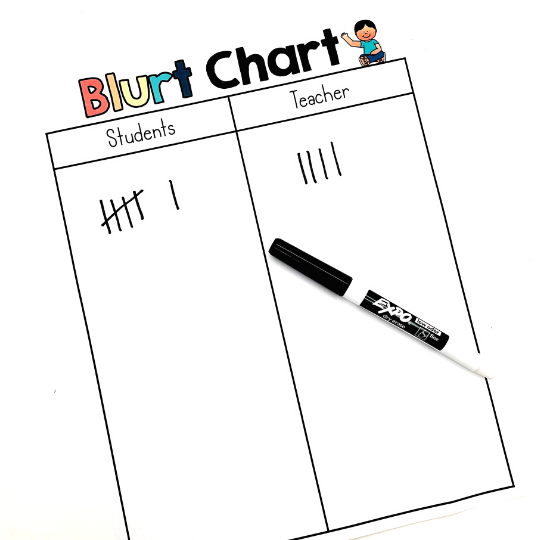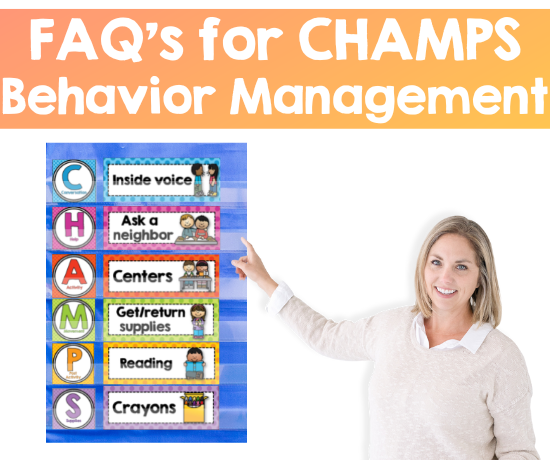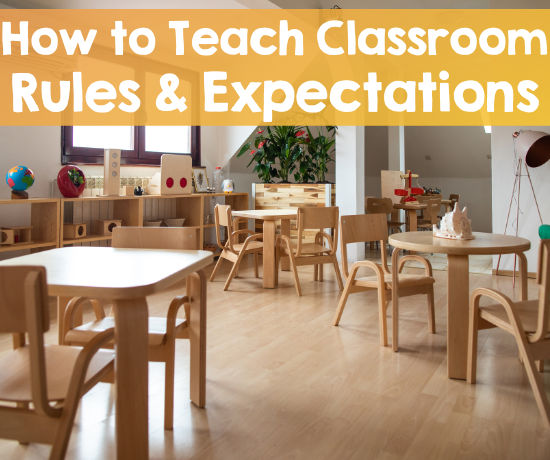Every single year I forget how emotionally and physically exhausting the first few weeks of kindergarten are! Most students are not ready to sit still and focus on their work. Today I’m going to share with you 6 quick and easy behavior management tips for kindergarten to help get you and your students on the same page.
#1 – Procedural Review
We all know that the first few weeks are spent teaching a wide array of procedures. Most procedures need to be taught multiple times.
To do a procedural review, teach a procedure and ask the students to demonstrate what they’ve just learned. Stand back and observe how well they are meeting expectations.
For example, teach them how to quietly go back to their seats from the rug and begin working independently. Notice their voice levels, how quickly they get to work, how they do at gathering supplies etc. Assign a rating to how they did from 1-5.
Say – “Great job! That was a 3. Let’s work on walking to our chairs (not running) and finding our pencils quickly.
Next time they are being dismissed from the rug, remind them of the procedure expectations and remind them how they got a 3 last time. Challenge them to get an even higher score!
Once they reach a score of 5 and have the procedure down pretty well give them TONS of praise. You can also give them a class point and work toward a class prize together. Students find this rating system highly motivating and work hard to get that 5!
#2 – Praise the Good, Ignore the Bad
In almost all circumstances in kindergarten, you will get much more out of students by praising the positive behavior and ignoring the negative.
This obviously doesn’t count when a student is doing something dangerous or harmful. That kind of behavior needs to be stopped immediately.
For example, if I see a student misbehaving on the rug, I will immediately find a student who is doing the right thing and praise them. I won’t say anything to the student who is not meeting expectations.
Say -“James, I love how you are sitting quietly with your hands in your lap!” Follow this up with an individual point on something like Class Dojo and you will have the rest of the class quickly falling in line.
I usually praise a couple more students and award some more points to drive home the expectation.
For students who have a difficult time following expectations, you will need to praise them more often. The moment you see them making a positive choice call it out and award them a point.
This can get tiresome but in the end, you’ll get the behavior you are hoping for and you won’t have to do it as much as the year progresses.

#3 – Make it Their Choice
Giving a student a choice between two options – what you want them to do, and the consequence of what happens when they don’t, has always worked well for me.
Say – “You can either finish this work now, or you can finish it when we are doing centers (or another highly motivating activity).
By giving the students a choice, you put the ball in their court. This really helps them to see what they will be giving up if they make a negative choice.
The consequence isn’t really coming from the teacher anymore. The consequence is coming from the student’s own actions.
A couple of things to keep in mind with choices:
- I personally don’t believe it’s appropriate to take away recess time. Students who are acting out usually need this time the most.
- If a child continually chooses to do their work during the fun activity then this strategy is not working for them and you need to find another option.
- If a child continually struggles to finish their work on time they might need some assistance with time management skills. They might also need to have modifications made to their work expectations.
This strategy doesn’t work for every child, but in my experience, it works for 9 out of 10 kids by putting them in control of their own destiny.
#4 – Control the Blurt
The first couple of weeks are especially difficult for students to remember to raise their hand when they have a question or comment.
Having a simple tally chart can go a long way in curbing this issue. Every time someone blurts something out without raising their hand, the teacher gets a point. If you get through an entire section of your lesson (no more than 5-7 minutes) without any interruptions the students get a point.
At the end of the day, you can tally up who has the most points. If the students win they get a small prize such as a treat or maybe a couple of extra minutes of recess. I made this quick tally sheet and if you would like to download it just fill out the information below.
This is another behavior management tool that shouldn’t have to be used much after the first couple of weeks. Although, you might have to bust it out after Winter/Spring break just as a reminder.
Two side notes about a teacher’s voice – During my teacher observations as a VP, I saw a lot of newer teachers talk over the students instead of stopping the lesson and addressing the behavior.
Even though it takes away precious time, you have to stop each time and take care of the side talking. It won’t be long before they learn that when the teacher is talking they need to listen.
Additionally, when I was first starting out as a teacher I read the classic – The First Days of School by Harry and Rosemary Wong. This quote was something that really stuck with me as I started teaching.
“You do not need to speak loudly. The most effective teachers have a firm but gentle voice. Learn to ‘speak loudly’ with your tone, not your volume. When you speak softly, the class listens carefully, You modulate the noise level of the class by the loudness of your voice.”
-Harry and Rosemary Wong
#5 – Rule Reminders
In my classroom, part of the calendar person’s job is to review the rules every day. I have 5 rules and post them in bright colorful signs in my calendar area. The students recite the rules every day and in the first week, we work on coloring pages that correspond to the rules.
When I notice a negative behavior I stop and ask – “What was rule #2 again?” All of the students will recite – “Listen when someone is speaking!”
I say thank you, and we move on with the lesson. I don’t need to call out the individual who was causing a disruption. This is a quick and easy way to get students back on track.

#6 – Be Flexible
I honestly don’t think there are two years that I have taught, that I was able to use the exact same behavior plan.
I always have to change something up based on what motivates a particular group of students. It’s not hard to tweak little things to match your student’s interests.
Pay attention to what they get excited about. Work on some graphing skills by asking them what kind of class prize they would prefer.
The same thing goes for individual behavior plans. I know you’ve heard it said a million times – Build relationships first! Find out what motivates each child and what is at the root of their struggles and you’ll get on the same page much faster!
I hope you found these quick and easy behavior management tips for kindergarten helpful! Check out my other behavior management posts to get more ideas on how to cultivate a smooth-running classroom!







